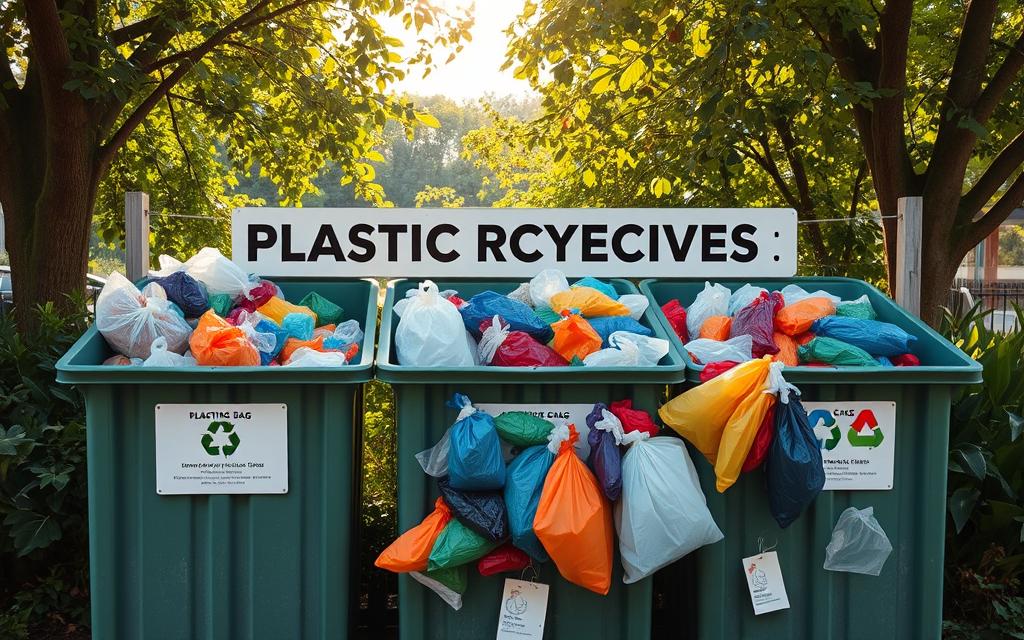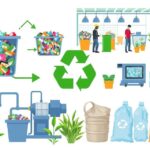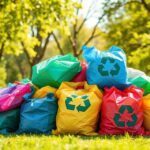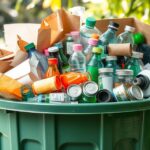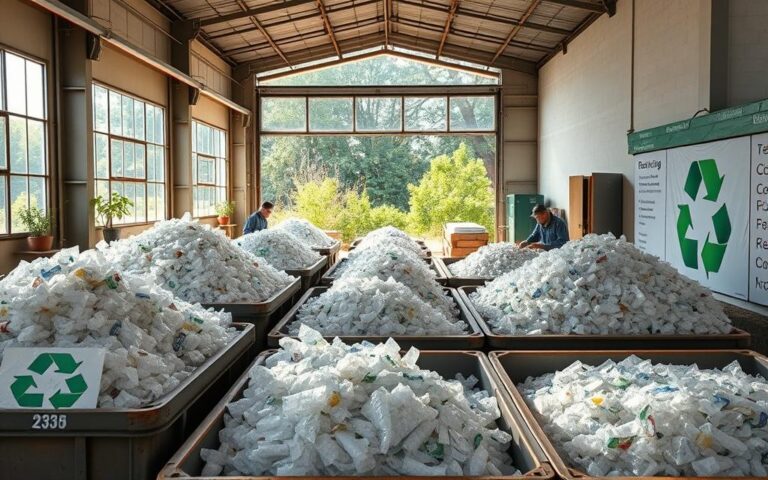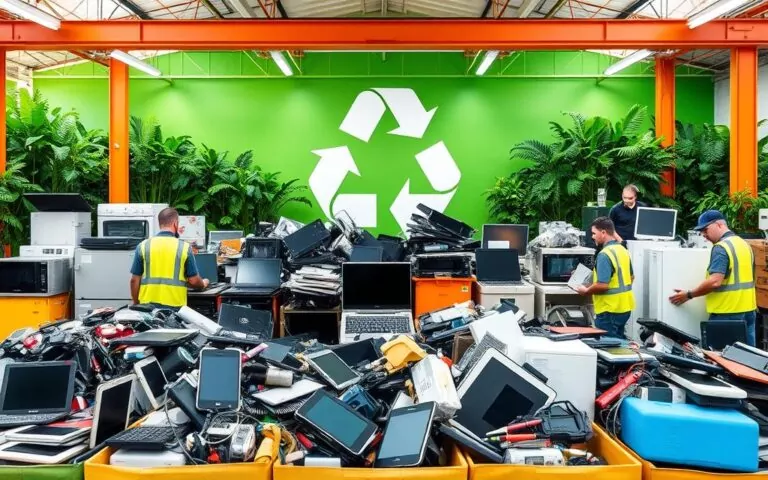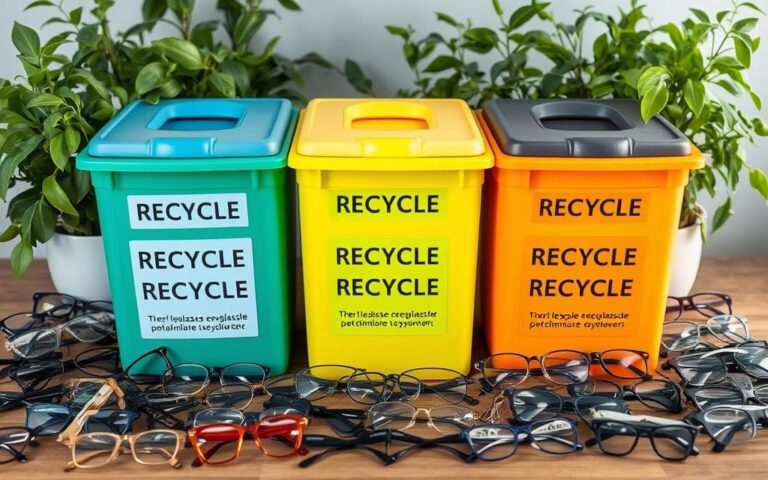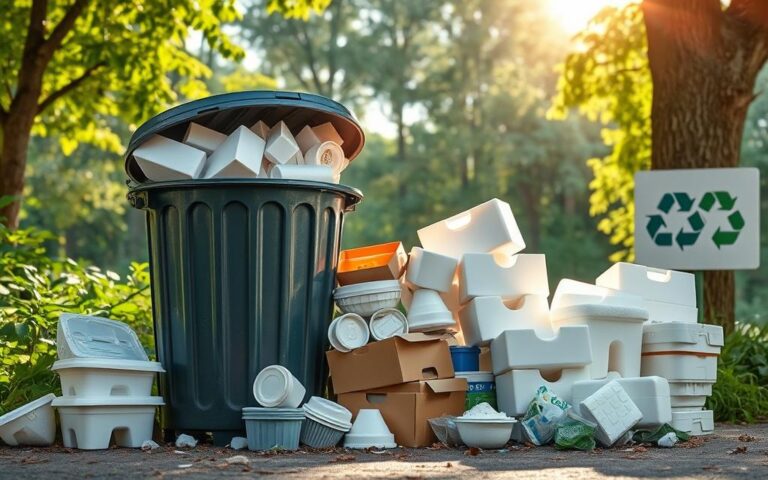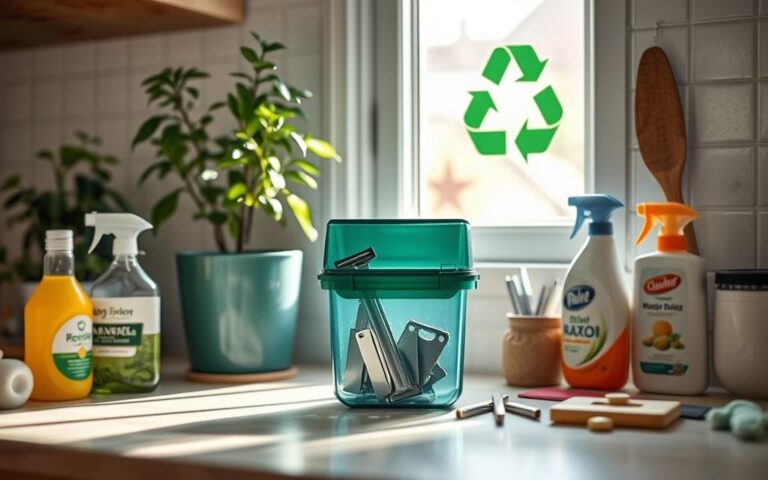Are Plastic Shopping Bags Recyclable? Drop-Off Locations
These days, we all wonder if we can recycle plastic shopping bags. Recycling these bags is vital for cutting down waste and saving our earth. Yet, a lot of us don’t know the problems in getting rid of them. Since they can mess up recycling machines, we can’t just toss them in our home recycling bin. But we can take them to special places that accept them for recycling.
You can find bins for your plastic bags at many stores. Names you might know include Giant Eagle, Target, Lowe’s, and Whole Foods. It’s important we all use these bins to help control waste. This piece looks into why recycling plastic bags matters, what they’re made from, and how they’re recycled.
The Importance of Recycling Plastic Bags
Plastic bags are a big problem for the environment and wildlife. Knowing these problems helps us push for better recycling. Plastic has effects that stretch far and wide. It doesn’t just harm the land. Our seas suffer too, especially from plastic not thrown away properly. Talking about this makes the need to recycle plastic bags even clearer.
Environmental Impact of Plastic Bags
Plastic bags cause serious pollution issues. They’re mainly made of something called low-density polyethylene (LDPE). These bags can take more than 500 years to break down. This slow decay means waste keeps building up, messing up landscapes and filling landfills. The United States makes about 12% of the world’s waste but only has 4% of its people. This fact shows how much we throw away. And plastic bags? We use them for just 12 minutes before we get rid of them.
Marine Debris and Wildlife Hazard
Plastic bags are dangerous for sea animals too. Once they reach the ocean, they turn into deadly trash. Ocean animals might think they’re food. This can make them very sick or even kill them. Workers at places like Eureka Recycling spend lots of time removing plastic bags from machines. This shows how much of a problem it is. To help wildlife, we need to teach people and have good recycling programs. Big shops like Kroger and Walmart already have places where you can leave plastic bags for recycling.
Understanding Plastic Bag Materials
It’s important to know about plastic bag materials for good recycling. Different kinds of plastic bags are made for various uses. The most common materials are high-density polyethylene (HDPE) and low-density polyethylene (LDPE).
Types of Plastics: HDPE and LDPE
There are mainly two types of polyethylene used in plastic bags:
- High-Density Polyethylene (HDPE) – This is #2 plastic, which makes stronger bags like the ones from supermarkets.
- Low-Density Polyethylene (LDPE) – Recognised as #4 plastic, it’s used for softer bags, like those for fruit and bread.
Both kinds are accepted at places where you can drop off plastic for recycling. Knowing about these helps us make better choices when throwing them away or recycling.
Identification Through Recycling Symbols
Understanding recycling symbols is key. These symbols tell us what plastic it is and if we can recycle it. HDPE and LDPE bags can be easily spotted:
| Plastic Type | Symbol | Common Uses |
|---|---|---|
| High-Density Polyethylene (HDPE) | #2 | Grocery bags, milk jugs, detergent bottles |
| Low-Density Polyethylene (LDPE) | #4 | Produce bags, bread bags, some food wraps |
Remember, not all plastic like those from frozen food bags or chip packets can be recycled. They must go in the bin. Always remove stickers or leftover food to keep recycling clean.
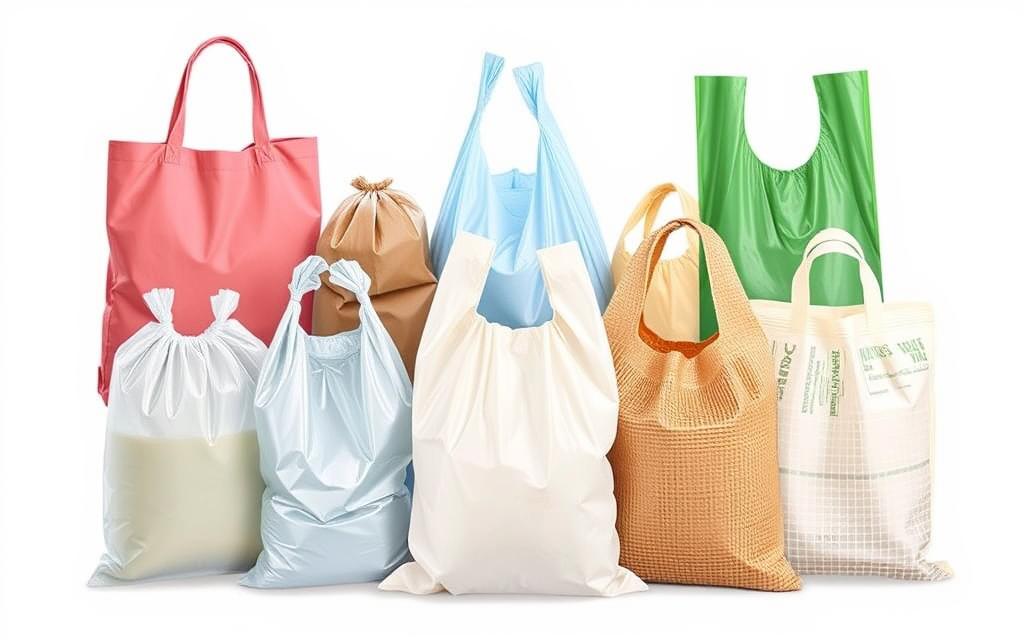
Are Plastic Shopping Bags Recyclable?
The debate about recycling plastic shopping bags is heated, especially concerning curbside recycling issues. Many places find it hard to recycle them regularly. They often jam machinery at recycling centres, causing delays and extra costs. That’s why many local recycling schemes don’t accept them.
Challenges in Curbside Recycling
Though there’s a push for recycling plastic bags, only about 6% gets recycled in the US. Most are burned, buried, or become litter. In California, despite a ban aimed at cutting plastic waste, more bags are ending up in landfills. Wrong items thrown in recycling bins cause big problems, and plastic bags are a major culprit.
Store Drop-off Recycling Options
Store drop-off recycling poses an alternative amid curbside recycling issues. Many supermarkets have bins specifically for recycling plastic bags, including other plastic wraps. Look for signs like the How2Recycle label to know where you can recycle. Though paused during the pandemic, these programs are mostly back.
Before recycling, make sure the bags are clean and dry. Dirty bags can spoil the recycling batch, making it tougher to process. By using these drop-off spots, we help lessen plastic waste and support greener methods.
| Type of Plastic | Acceptable for Drop-off Recycling | Not Acceptable for Drop-off Recycling |
|---|---|---|
| Plastic Shopping Bags | Yes | Loose bags in curbside bins |
| Bubble Wrap | Yes | Plastic shipping envelopes |
| Zipper-top Food Bags | Yes | Cereal box liners |
| Produce Bags | Yes | Biodegradable bags |
Preparation for Plastic Bag Recycling
Getting plastic bags ready for recycling is key. They must be clean and dry. Leftover food or liquids can spoil the whole batch. Knowing the right way to prepare them makes recycling easier and more successful.
Importance of Clean and Dry Bags
Recycling centres can only work with clean plastic bags. Dirty bags won’t be processed. To get them ready, wash and let them air dry. This is vital for HDPE and LDPE bags, but not for biodegradable or foil-lined ones. If they’re clean, they’re more likely to be recycled.
How to Collect and Store Plastic Bags at Home
It’s important to gather and keep bags properly. Follow these plastic bag storage tips:
- Choose a spot just for plastic bags.
- Store them in a dry place away from the sun to avoid damage.
- Check for any bags that are too worn out to be recycled.
- Only keep bags that can be recycled, as shown by a number inside the recycling symbol.
Using these pointers can push up the rate of clean plastic recycling. Doing so helps our community and our planet. It shows how each of us can make a difference with good recycling habits.
Finding Drop-Off Locations
It’s vital to find the right spots for dropping off plastic bags to recycle them. Right now, only 3% of plastic bags get recycled. Shops like local grocers have bins at their doors for this. Knowing about these can push us towards more eco-friendly habits.
National Grocery Retailers Offering Recycling Bins
Big supermarkets are stepping up their game by offering places to recycle plastic bags. Kroger, Safeway, Target, and Walmart have these bins ready for us. This makes it easy to recycle right after shopping. We must use these spots to boost recycling numbers.
Using Online Directories and Resources
For better recycling, tools like the NexTrex Directory are key. They tell you where to go to recycle bags. Recycling rules change, so it’s good to keep up. Using these resources helps you recycle the right way and supports community efforts against plastic waste.
The Recycling Process of Plastic Bags
The journey of plastic bags starts when they are collected. It’s key to know the whole recycling process of these bags. After you drop off bags at special spots, they are picked up. Then, they are taken to recycling centres for a true transformation.
Collection to Reprocessing: What Happens After Drop-off?
First, the collected plastic bags are squashed into big bales. These bales are sold to companies that process plastic. After that, the bags are shredded into small bits. They are then turned into tiny beads. These beads are crucial as they form the base for various recycled products. These products help make new items, promoting a cycle of use.
End Products from Recycled Plastic Bags
Recycled plastic bags transform into many different items. They are mostly turned into composite lumber. This lumber is used to build park benches, decks, and fences. It’s even used in playgrounds. The beads might also make new bags, pallets, containers, and pipes. This shows how recycling plastic bags can lessen waste and help the environment.
| Recycled Product | Uses |
|---|---|
| Composite Lumber | Parks benches, decks, fences |
| Pellets | New bags, containers, pallets |
| Post-consumer Resin | Crates, pipes |
By recycling plastic bags, everyone can help cut down on waste. This supports eco-friendly actions. Every small act helps in making our planet greener.
Conclusion
Plastic bag recycling is key to our planet’s health. Every year, 500 billion bags are used worldwide. But, only 1 out of 200 gets recycled. This fact shows how vital recycling is. Most bags end up polluting, causing big problems for disposing of waste. We can cut down this plastic issue by supporting bag drop-off spots and recycling them right.
Choosing to be eco-friendly is crucial for lessening our waste and helping the earth. In Ireland, a tax on plastic bags significantly cut their use. We all need to pick reusable bags and join recycling efforts in our areas. By doing this, we can hope to see a huge drop in plastic pollution. This will safeguard sea life and boost the environment’s health.
The road to sustainability needs us to make deliberate choices and act together. Knowing about plastic bag recycling and promoting right disposal helps the earth. Let’s keep recycling as a key part of our life. And let’s encourage everyone to fight for a green, sustainable future.
FAQ
Are plastic shopping bags recyclable?
Yes, plastic shopping bags can be recycled. Yet, they don’t go in your home recycling bin. Take them to specific locations at stores that collect plastic bags for recycling.
What environmental issues do plastic bags cause?
Plastic bags cause big problems, including pollution and harming sea life. They often end up in the ocean, where creatures might eat them. This can make them sick or even kill them.
How can I identify the type of plastic in shopping bags?
Check for recycling symbols on the bags to find out what plastic they’re made of. Shopping bags are usually made of high-density polyethylene (HDPE or #2 plastic) or low-density polyethylene (LDPE or #4 plastic).
What are the challenges with curbside recycling of plastic bags?
Curbside recycling schemes struggle with plastic bags. They can mix with other recyclables wrongly and disrupt the recycling process. Many local councils won’t take them in curbside recycling for these reasons.
How can I prepare my plastic bags for recycling?
Make sure the bags are clean and dry before recycling. Leftover materials can spoil the whole recycling batch. Having a separate bin for storing them makes it easier to drop them off for recycling later.
Where can I find drop-off locations for recycling plastic bags?
Look for recycling bins at big supermarkets like Tesco, Sainsbury’s, and Morrisons. The NexTrex Directory online is also handy for finding places to take your bags.
What happens to plastic bags after they are collected for recycling?
Once collected, the bags are packed up and sold to recycling firms. They turn them into small pellets. These pellets become new items, like park benches, decks, or even new bags. This helps the environment by keeping resources in use.

